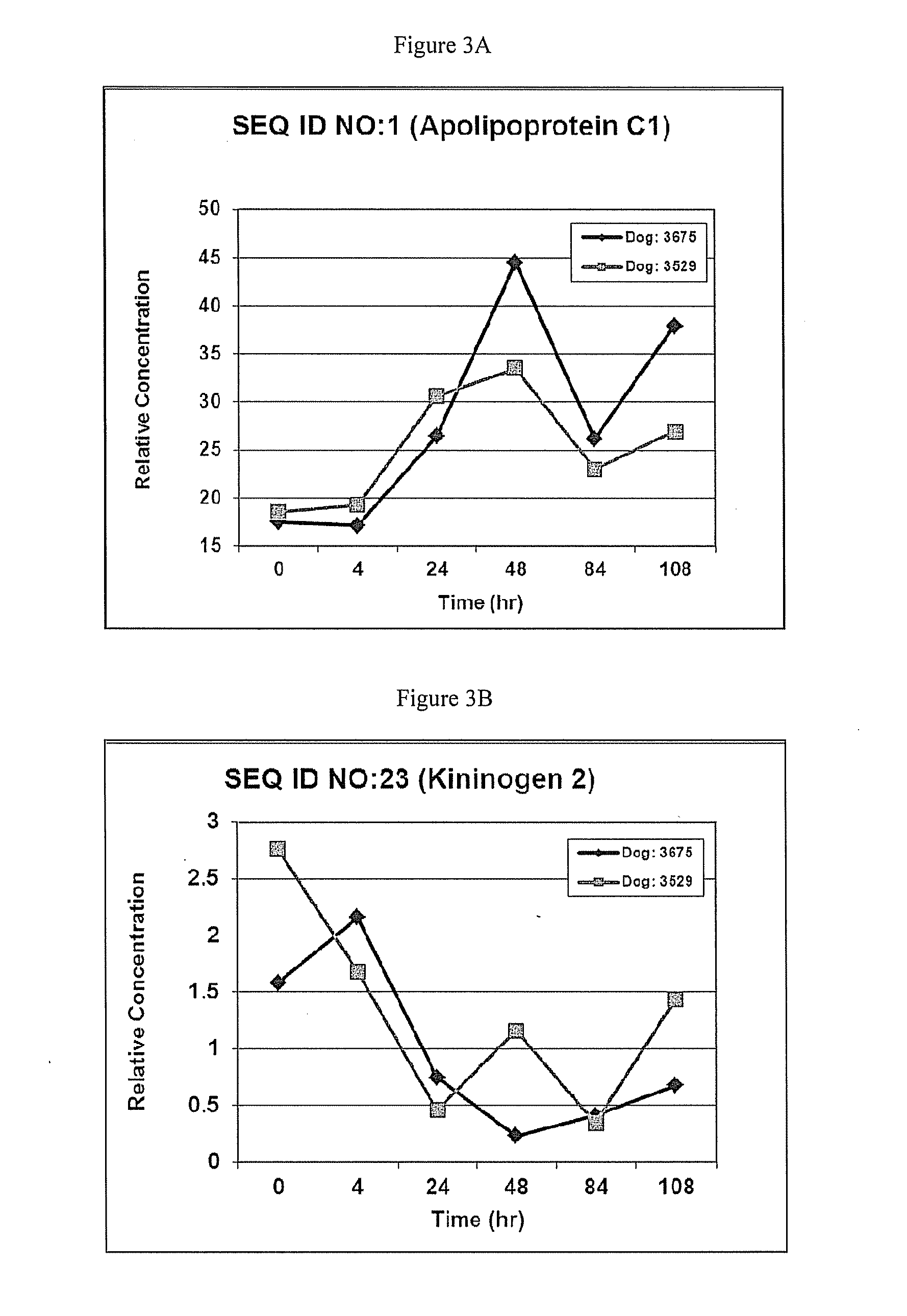Markers for Renal Disease
a technology for renal disease and markers, applied in the field of markers for renal disease, can solve the problems of inability to cure chronic renal disease, slow disease progression, and irreparable kidney damage, and achieve the effect of reducing patient discomfort and more timely assessmen
- Summary
- Abstract
- Description
- Claims
- Application Information
AI Technical Summary
Benefits of technology
Problems solved by technology
Method used
Image
Examples
example 1
Identification and Purification of Blood Samples
[0084]Patient blood samples were collected from dogs. The dogs were members of a single family maintained at Texas A & M University since 1997. More specifically, this family is a colony of heterozygous (carrier) females with X-linked hereditary neuropathy (XLHN). XLHN is caused by a mutation in the gene COL4A5 which in the female dogs causes a mosaic expression of type IV collagen peptides and onset of glomerular proteinuria between 3 and 6 months of age. Nabity et al., J Vet Intern Med 2007; 21:425-430. Control versus experimental (diseased) was selected wherein controls were healthy dogs and the experimental or diseased group were dogs exhibiting elevated creatinine levels.
[0085]The following procedure was utilized for the preparation of patient samples for experimental analysis. Utilizing a 0.5 mL protein LoBind eppendorf tube, 110 uL of serum was precipitated by addition of 200 uL N,N-dimethylacetamide, which was followed by vorte...
example 2
Identification of Polypeptides in Diseased Does by Liquid Chromatography / Mass Spectrometry
[0088]Experimental and control samples were subjected to liquid chromatography / mass spectrometry (LC / MS) for the identification of differentially produced polypeptides by mass. The identified polypeptide masses were then annotated to determine the corresponding protein name by performing a peptide ID search of existing databases. A unique databases for peptide annnotation was created from NCBI, Swissprot, Uniprot.
[0089]The resulting data provided the polypeptides provided in Table 1. SEQ ID NOS: 1-59 are the polypeptides that were differentially produced in dogs with renal disease. Therefore, these polypeptides provide unique biomarkers for the detection renal disease in dogs.
TABLE 1Polypeptides differentially produced in dogs with renal disease.ExpressionAccessionNo. PeptidesNo. AAsMW [kDa]DescriptionLevelsP56595 3889.7ApolipoproteinIncreasedC-IOS = CanisfamiliarisGN = APOC1PE = 2SV = 1-[APOC1...
example 3
Inosine Concentrations in Dogs with Renal Disease
[0095]Dog serum was obtained from field samples submitted to IDEXX Reference Laboratories. Dogs were of various breeds and ages. 25 samples with 1.8 mg / dL serum creatinine were assigned to a high creatinine group. Again, high creatinine is associated with renal disease, therefore inosine levels were assessed to determine whether inosine could be a biomarker for reduced kidney function.
[0096]Serum samples from a high creatinine and normal creatinine canine populations were analyzed on LC / MS and differentially produced mass features were indentified by informatics as previously described. LC / MS was run for each sample (i.e., dog) individually. SIEVE software (Thermo Scientific, Waltham, Mass.) was used for statistical analysis of the LC / MS data. Raw LC / MS data files were loaded into SIEVE, and peaks were identified. Statistical analysis was performed to compare peaks in low creatinine and high creatinine samples. A differential peak cor...
PUM
| Property | Measurement | Unit |
|---|---|---|
| Temperature | aaaaa | aaaaa |
| Mass | aaaaa | aaaaa |
| Mass | aaaaa | aaaaa |
Abstract
Description
Claims
Application Information
 Login to View More
Login to View More - R&D
- Intellectual Property
- Life Sciences
- Materials
- Tech Scout
- Unparalleled Data Quality
- Higher Quality Content
- 60% Fewer Hallucinations
Browse by: Latest US Patents, China's latest patents, Technical Efficacy Thesaurus, Application Domain, Technology Topic, Popular Technical Reports.
© 2025 PatSnap. All rights reserved.Legal|Privacy policy|Modern Slavery Act Transparency Statement|Sitemap|About US| Contact US: help@patsnap.com



